供应链管理
- 格式:docx
- 大小:18.85 KB
- 文档页数:9
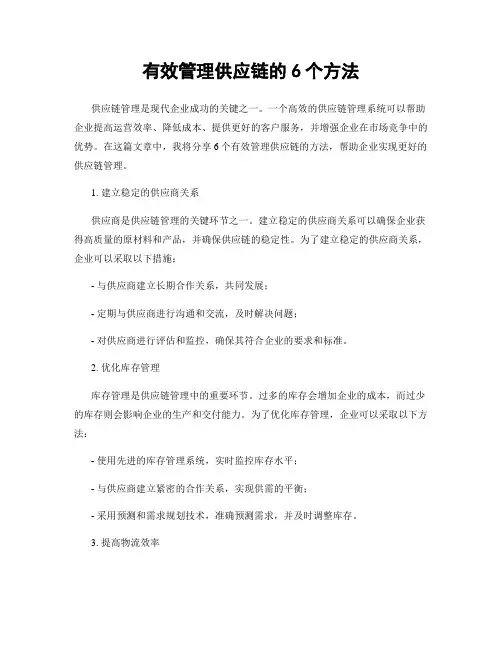
有效管理供应链的6个方法供应链管理是现代企业成功的关键之一。
一个高效的供应链管理系统可以帮助企业提高运营效率、降低成本、提供更好的客户服务,并增强企业在市场竞争中的优势。
在这篇文章中,我将分享6个有效管理供应链的方法,帮助企业实现更好的供应链管理。
1. 建立稳定的供应商关系供应商是供应链管理的关键环节之一。
建立稳定的供应商关系可以确保企业获得高质量的原材料和产品,并确保供应链的稳定性。
为了建立稳定的供应商关系,企业可以采取以下措施:- 与供应商建立长期合作关系,共同发展;- 定期与供应商进行沟通和交流,及时解决问题;- 对供应商进行评估和监控,确保其符合企业的要求和标准。
2. 优化库存管理库存管理是供应链管理中的重要环节。
过多的库存会增加企业的成本,而过少的库存则会影响企业的生产和交付能力。
为了优化库存管理,企业可以采取以下方法:- 使用先进的库存管理系统,实时监控库存水平;- 与供应商建立紧密的合作关系,实现供需的平衡;- 采用预测和需求规划技术,准确预测需求,并及时调整库存。
3. 提高物流效率物流是供应链管理中不可忽视的一环。
提高物流效率可以减少运输时间和成本,并提供更好的客户服务。
为了提高物流效率,企业可以采取以下措施:- 优化物流网络,选择合适的运输方式和路线;- 使用先进的物流管理系统,实时跟踪货物的运输状态;- 与物流服务提供商建立紧密的合作关系,确保货物的及时交付。
4. 加强信息共享和沟通信息共享和沟通是供应链管理中至关重要的一环。
良好的信息共享和沟通可以帮助企业及时获取市场信息、预测需求,并与供应商和客户保持紧密联系。
为了加强信息共享和沟通,企业可以采取以下措施:- 使用先进的信息管理系统,实现信息的实时共享和传递;- 与供应商和客户建立紧密的合作关系,共享市场信息和需求预测;- 定期组织会议和培训,加强内部和外部的沟通和交流。
5. 实施供应链风险管理供应链管理中存在各种潜在的风险,如供应商倒闭、天灾人祸等。
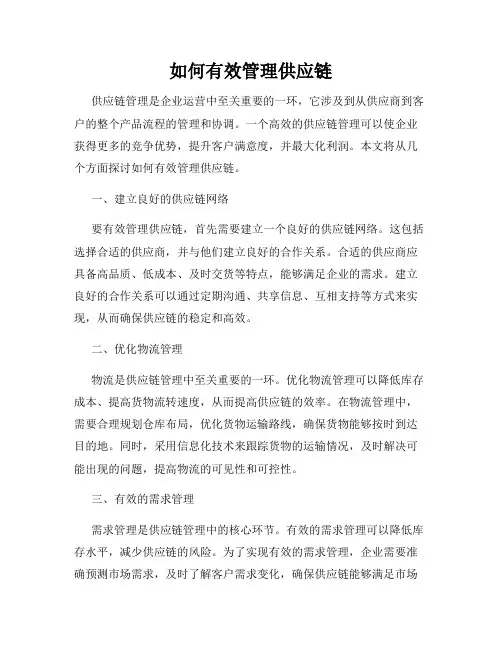
如何有效管理供应链供应链管理是企业运营中至关重要的一环,它涉及到从供应商到客户的整个产品流程的管理和协调。
一个高效的供应链管理可以使企业获得更多的竞争优势,提升客户满意度,并最大化利润。
本文将从几个方面探讨如何有效管理供应链。
一、建立良好的供应链网络要有效管理供应链,首先需要建立一个良好的供应链网络。
这包括选择合适的供应商,并与他们建立良好的合作关系。
合适的供应商应具备高品质、低成本、及时交货等特点,能够满足企业的需求。
建立良好的合作关系可以通过定期沟通、共享信息、互相支持等方式来实现,从而确保供应链的稳定和高效。
二、优化物流管理物流是供应链管理中至关重要的一环。
优化物流管理可以降低库存成本、提高货物流转速度,从而提高供应链的效率。
在物流管理中,需要合理规划仓库布局,优化货物运输路线,确保货物能够按时到达目的地。
同时,采用信息化技术来跟踪货物的运输情况,及时解决可能出现的问题,提高物流的可见性和可控性。
三、有效的需求管理需求管理是供应链管理中的核心环节。
有效的需求管理可以降低库存水平,减少供应链的风险。
为了实现有效的需求管理,企业需要准确预测市场需求,及时了解客户需求变化,确保供应链能够满足市场需求。
此外,采用合适的库存管理方法,如Just in Time( JIT)等,可以最大程度地减少库存,提高供应链的灵活性和响应速度。
四、信息共享与协作供应链管理需要各个环节之间的紧密合作和信息共享。
通过信息共享,各个环节能够更好地协调和配合,从而提高供应链的协同效应。
信息共享可以通过信息化系统来实现,如企业资源规划(ERP)系统、供应链管理系统等。
这些系统能够实时跟踪和共享各个环节的信息,提供准确的数据支持和决策依据。
五、持续改进与创新供应链管理需要不断进行持续改进与创新。
通过持续改进,可以发现并解决问题,提高供应链的效率和质量。
而创新则能够推动供应链管理的发展,提供新的竞争优势。
企业可以引入新的技术和方法,开展供应链优化项目,不断提高供应链的运作效能。
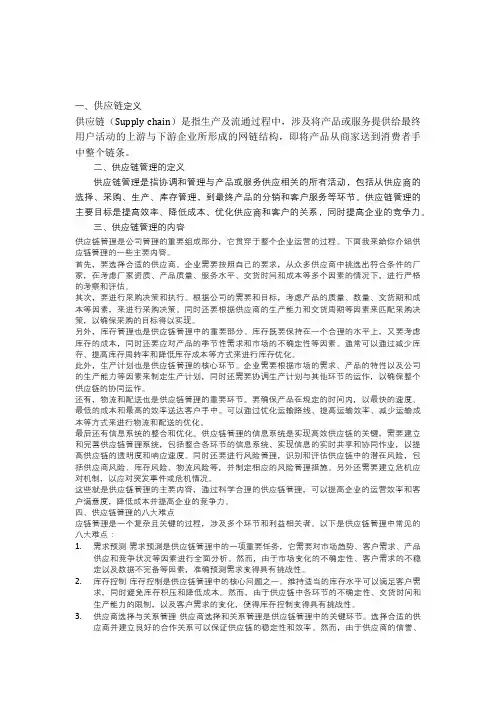
一、供应链定义供应链(Supply chain)是指生产及流通过程中,涉及将产品或服务提供给最终用户活动的上游与下游企业所形成的网链结构,即将产品从商家送到消费者手中整个链条。
二、供应链管理的定义供应链管理是指协调和管理与产品或服务供应相关的所有活动,包括从供应商的选择、采购、生产、库存管理,到最终产品的分销和客户服务等环节。
供应链管理的主要目标是提高效率、降低成本、优化供应商和客户的关系,同时提高企业的竞争力。
三、供应链管理的内容供应链管理是公司管理的重要组成部分,它贯穿于整个企业运营的过程。
下面我来给你介绍供应链管理的一些主要内容。
首先,要选择合适的供应商。
企业需要按照自己的要求,从众多供应商中挑选出符合条件的厂家,在考虑厂家资质、产品质量、服务水平、交货时间和成本等多个因素的情况下,进行严格的考察和评估。
其次,要进行采购决策和执行。
根据公司的需要和目标,考虑产品的质量、数量、交货期和成本等因素,来进行采购决策。
同时还要根据供应商的生产能力和交货周期等因素来匹配采购决策,以确保采购的目标得以实现。
另外,库存管理也是供应链管理中的重要部分。
库存既要保持在一个合理的水平上,又要考虑库存的成本,同时还要应对产品的季节性需求和市场的不确定性等因素。
通常可以通过减少库存、提高库存周转率和降低库存成本等方式来进行库存优化。
此外,生产计划也是供应链管理的核心环节。
企业需要根据市场的需求、产品的特性以及公司的生产能力等因素来制定生产计划,同时还需要协调生产计划与其他环节的运作,以确保整个供应链的协同运作。
还有,物流和配送也是供应链管理的重要环节。
要确保产品在规定的时间内,以最快的速度、最低的成本和最高的效率送达客户手中。
可以通过优化运输路线、提高运输效率、减少运输成本等方式来进行物流和配送的优化。
最后还有信息系统的整合和优化。
供应链管理的信息系统是实现高效供应链的关键,需要建立和完善供应链管理系统,包括整合各环节的信息系统、实现信息的实时共享和协同作业,以提高供应链的透明度和响应速度。
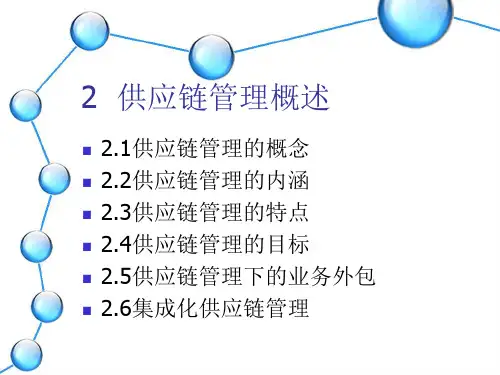

供应链管理(一)供应链定义供应链(supply chain)是围绕核心企业,通过对信息流、物流、资金流的控制,从采购原材料开始,制成中间产品以及最终产品,最后由销售网络把产品送到消费者手中的将供应商、制造商、分销商、零售商、直到最终用户连成一个整体的功能网链结构模式。
(二)供应链管理定义供应链管理是一种集成的管理思想和方法,它执行供应链中从供应商到最终用户的物流的计划和控制等职能。
从单一的企业角度来看,是指企业通过改善上、下游供应链关系,整合和优化供应链中的信息流、物流、资金流,以获得企业的竞争优势。
供应链管理的目的在于提高顾客服务水平和降低总成本。
(三)供应链管理原则➢竞争不再是单个企业的竞争,而是供应链与供应链的竞争➢以全局最优代替局部最优☑考虑决策问题是基于包括多家成员企业的整个供应链系统,而非仅从企业自身角度出发➢双赢策略☑合作并共享成本降低利润增加的成果,不是你赢我输,讨价还价的关系➢外包策略☑企业专注于自己核心专长,擅长的业务领域,将不擅长的业务领域外包给合作伙伴,从而使得整个供应链的竞争力提高➢战略伙伴关系☑供应链伙伴的合作:战略高度、长期的关系、相互信任、多层次协同,信息共享(四)供应链管理与传统管理的区别①供应链管理把供应链中所有节点企业看作一个整体。
②供应链管理强调和依赖战略管理。
③供应链管理最关键的是需要采用集成的思想和方法。
④供应链管理具有更高的目标,通过管理库存和合作关系去达到高水平的服务,而不是仅仅完成一定的市场目标。
(五)牛鞭效应定义和对供应链的影响及危害定义:订单数量的变动幅度会在供应链中不断被放大,越往上游变动幅度越大。
此一变异不断增加的现象称为牛鞭效应。
你所看到的并不是你所面临的真实情况。
影响及危害:①需求预测--供应链各层次所使用的传统库存管理技术导致了牛鞭效应。
②提前期--提前期越长,需求变动性的微小变化意味着安全库存和订货点的很大的变化,因此订货量发生很大变化。
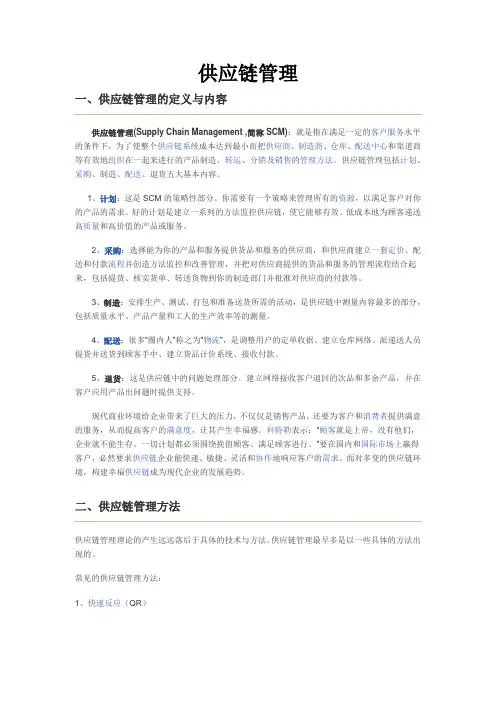
供应链管理一、供应链管理的定义与内容供应链管理(Supply Chain Management ,简称SCM):就是指在满足一定的客户服务水平的条件下,为了使整个供应链系统成本达到最小而把供应商、制造商、仓库、配送中心和渠道商等有效地组织在一起来进行的产品制造、转运、分销及销售的管理方法。
供应链管理包括计划、采购、制造、配送、退货五大基本内容。
1、计划:这是SCM的策略性部分。
你需要有一个策略来管理所有的资源,以满足客户对你的产品的需求。
好的计划是建立一系列的方法监控供应链,使它能够有效、低成本地为顾客递送高质量和高价值的产品或服务。
2、采购:选择能为你的产品和服务提供货品和服务的供应商,和供应商建立一套定价、配送和付款流程并创造方法监控和改善管理,并把对供应商提供的货品和服务的管理流程结合起来,包括提货、核实货单、转送货物到你的制造部门并批准对供应商的付款等。
3、制造:安排生产、测试、打包和准备送货所需的活动,是供应链中测量内容最多的部分,包括质量水平、产品产量和工人的生产效率等的测量。
4、配送:很多“圈内人”称之为“物流”,是调整用户的定单收据、建立仓库网络、派递送人员提货并送货到顾客手中、建立货品计价系统、接收付款。
5、退货:这是供应链中的问题处理部分。
建立网络接收客户退回的次品和多余产品,并在客户应用产品出问题时提供支持。
现代商业环境给企业带来了巨大的压力,不仅仅是销售产品,还要为客户和消费者提供满意的服务,从而提高客户的满意度,让其产生幸福感。
科特勒表示:“顾客就是上帝,没有他们,企业就不能生存。
一切计划都必须围绕挽留顾客、满足顾客进行。
”要在国内和国际市场上赢得客户,必然要求供应链企业能快速、敏捷、灵活和协作地响应客户的需求。
面对多变的供应链环境,构建幸福供应链成为现代企业的发展趋势。
二、供应链管理方法供应链管理理论的产生远远落后于具体的技术与方法。
供应链管理最早多是以一些具体的方法出现的。
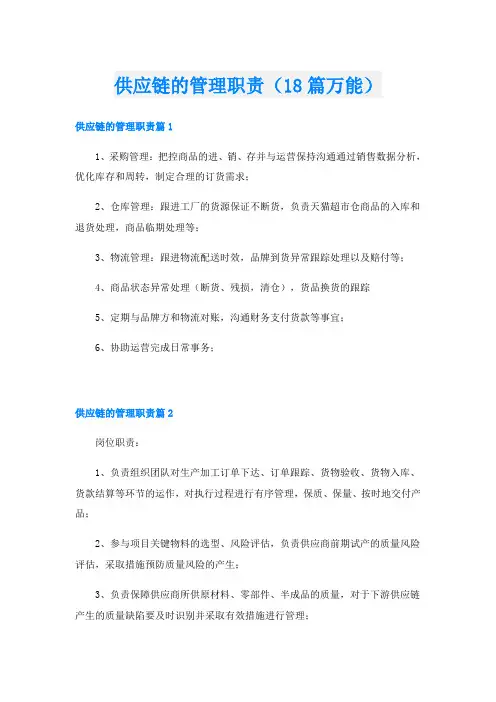
供应链的管理职责(18篇万能)供应链的管理职责篇11、采购管理:把控商品的进、销、存并与运营保持沟通通过销售数据分析,优化库存和周转,制定合理的订货需求;2、仓库管理:跟进工厂的货源保证不断货,负责天猫超市仓商品的入库和退货处理,商品临期处理等;3、物流管理:跟进物流配送时效,品牌到货异常跟踪处理以及赔付等;4、商品状态异常处理(断货、残损,清仓),货品换货的跟踪5、定期与品牌方和物流对账,沟通财务支付货款等事宜;6、协助运营完成日常事务;供应链的管理职责篇2岗位职责:1、负责组织团队对生产加工订单下达、订单跟踪、货物验收、货物入库、货款结算等环节的运作,对执行过程进行有序管理,保质、保量、按时地交付产品;2、参与项目关键物料的选型、风险评估,负责供应商前期试产的质量风险评估,采取措施预防质量风险的产生;3、负责保障供应商所供原材料、零部件、半成品的质量,对于下游供应链产生的质量缺陷要及时识别并采取有效措施进行管理;4、负责制定进货检验部门的检验规范及检验计划,并适时对检验员进行培训指导;5、负责oem加工厂质量检验培训,帮助oem加工厂建立质量管控体系,提高oem加工生产质量控制能力;6、负责供应商质量标准的确定和初始样品的批准;7、对现有供应商的质量状况进行绩效管理;8、主要负责sqe小组团队的管理统筹。
任职资格(上岗条件):1、本科及以上学历,机电相关专业;2、5年以上sqe团队管理经验;3、具有良好的品质原因分析及处理能力;4、具有良好的组织、协调、沟通能力;5、工作积极主动、认真负责、抗压能力强。
6、熟悉钣金焊接加工生产流程,有丰富的钣金加工供应商管理经验。
供应链的管理职责篇31、负责部门所需物资的采购,确定库存深度;2、审核各项采购计划,与第三方物流洽谈方案,严格控制采购成本,合理进行采购;3、负责解决物流跟踪、协调及解决;4、维护公司的利益,定期查验供应产品质量并解决,并建立供应商信誉评价制度及稳定地良性供货体系;5、指导并监督员工开展业务,提升团队工作能力,确保业务运作规范、高效。
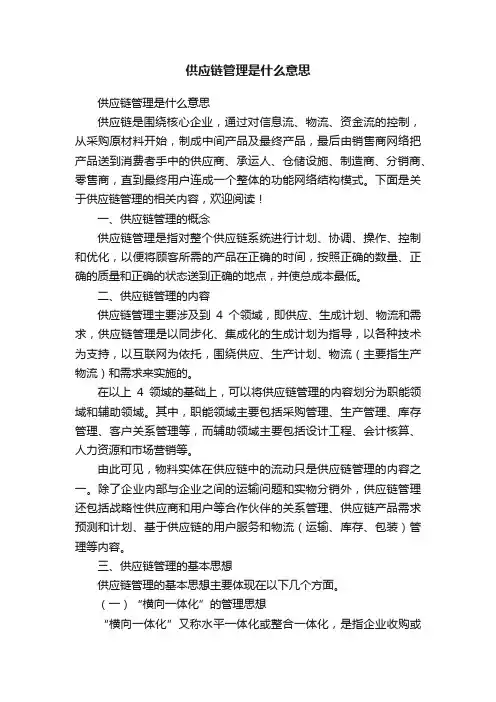
供应链管理是什么意思供应链管理是什么意思供应链是围绕核心企业,通过对信息流、物流、资金流的控制,从采购原材料开始,制成中间产品及最终产品,最后由销售商网络把产品送到消费者手中的供应商、承运人、仓储设施、制造商、分销商、零售商,直到最终用户连成一个整体的功能网络结构模式。
下面是关于供应链管理的相关内容,欢迎阅读!一、供应链管理的概念供应链管理是指对整个供应链系统进行计划、协调、操作、控制和优化,以便将顾客所需的产品在正确的时间,按照正确的数量、正确的质量和正确的状态送到正确的地点,并使总成本最低。
二、供应链管理的内容供应链管理主要涉及到4个领域,即供应、生成计划、物流和需求,供应链管理是以同步化、集成化的生成计划为指导,以各种技术为支持,以互联网为依托,围绕供应、生产计划、物流(主要指生产物流)和需求来实施的。
在以上4领域的基础上,可以将供应链管理的内容划分为职能领域和辅助领域。
其中,职能领域主要包括采购管理、生产管理、库存管理、客户关系管理等,而辅助领域主要包括设计工程、会计核算、人力资源和市场营销等。
由此可见,物料实体在供应链中的流动只是供应链管理的内容之一。
除了企业内部与企业之间的运输问题和实物分销外,供应链管理还包括战略性供应商和用户等合作伙伴的关系管理、供应链产品需求预测和计划、基于供应链的用户服务和物流(运输、库存、包装)管理等内容。
三、供应链管理的基本思想供应链管理的基本思想主要体现在以下几个方面。
(一)“横向一体化”的管理思想“横向一体化”又称水平一体化或整合一体化,是指企业收购或兼并同类产品生产企业以扩大经营规模的策略。
“横向一体化”的管理思想强调企业狠抓核心资源,以提高核心竞争力。
企业核心竞争力的形成,有助于保持和强化供应链上的合作伙伴关系。
(二)系统思想系统思想强调把供应链看成是一个整体,而不是由采购、制造、分销、零售等构成的一些分离的功能模块。
(三)合作性竞争合作性竞争可以从两个方面理解:一是与过去的竞争对手相互结盟,共同开发新技术,成果共享;二是将过去由本企业生产的非核心零部件外包给供应商,双方合作,共同参与竞争,这实际上也提现出核心竞争力的互补效应。
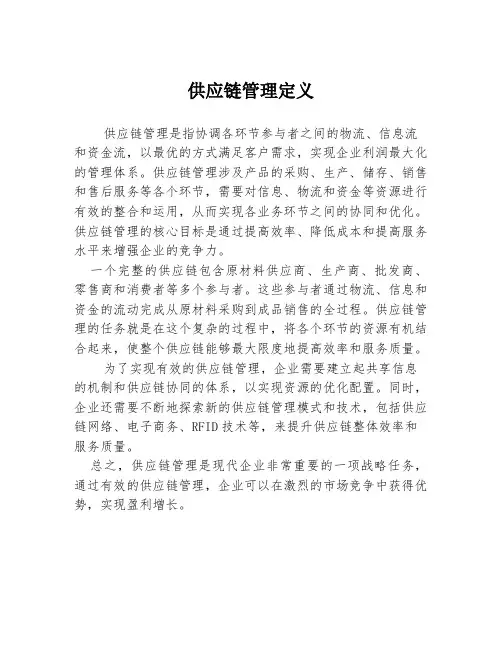
供应链管理定义
供应链管理是指协调各环节参与者之间的物流、信息流和资金流,以最优的方式满足客户需求,实现企业利润最大化的管理体系。
供应链管理涉及产品的采购、生产、储存、销售和售后服务等各个环节,需要对信息、物流和资金等资源进行有效的整合和运用,从而实现各业务环节之间的协同和优化。
供应链管理的核心目标是通过提高效率、降低成本和提高服务水平来增强企业的竞争力。
一个完整的供应链包含原材料供应商、生产商、批发商、零售商和消费者等多个参与者。
这些参与者通过物流、信息和资金的流动完成从原材料采购到成品销售的全过程。
供应链管理的任务就是在这个复杂的过程中,将各个环节的资源有机结合起来,使整个供应链能够最大限度地提高效率和服务质量。
为了实现有效的供应链管理,企业需要建立起共享信息的机制和供应链协同的体系,以实现资源的优化配置。
同时,企业还需要不断地探索新的供应链管理模式和技术,包括供应链网络、电子商务、RFID技术等,来提升供应链整体效率和服务质量。
总之,供应链管理是现代企业非常重要的一项战略任务,通过有效的供应链管理,企业可以在激烈的市场竞争中获得优势,实现盈利增长。
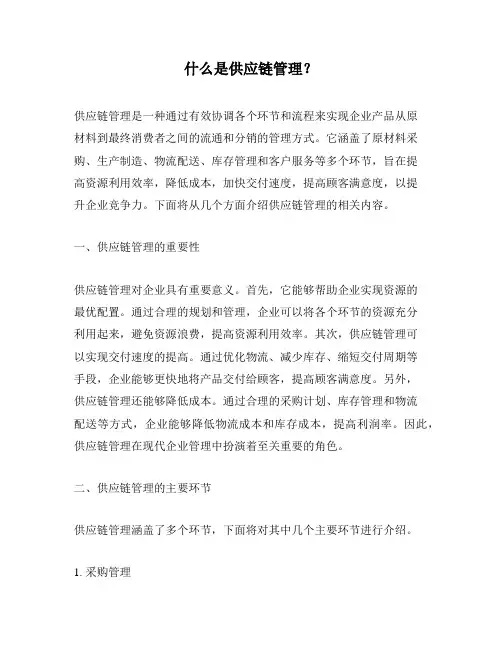
什么是供应链管理?供应链管理是一种通过有效协调各个环节和流程来实现企业产品从原材料到最终消费者之间的流通和分销的管理方式。
它涵盖了原材料采购、生产制造、物流配送、库存管理和客户服务等多个环节,旨在提高资源利用效率,降低成本,加快交付速度,提高顾客满意度,以提升企业竞争力。
下面将从几个方面介绍供应链管理的相关内容。
一、供应链管理的重要性供应链管理对企业具有重要意义。
首先,它能够帮助企业实现资源的最优配置。
通过合理的规划和管理,企业可以将各个环节的资源充分利用起来,避免资源浪费,提高资源利用效率。
其次,供应链管理可以实现交付速度的提高。
通过优化物流、减少库存、缩短交付周期等手段,企业能够更快地将产品交付给顾客,提高顾客满意度。
另外,供应链管理还能够降低成本。
通过合理的采购计划、库存管理和物流配送等方式,企业能够降低物流成本和库存成本,提高利润率。
因此,供应链管理在现代企业管理中扮演着至关重要的角色。
二、供应链管理的主要环节供应链管理涵盖了多个环节,下面将对其中几个主要环节进行介绍。
1. 采购管理采购管理是供应链管理的重要环节之一,其主要任务是根据企业需求,采购适当数量和质量的原材料和商品。
在采购过程中,企业需要与供应商建立合作关系,确保供应商能够及时提供所需的商品。
此外,采购管理还需要考虑成本、质量和交付周期等因素,以达到采购成本最小化和交付时间最短化的目标。
2. 生产制造生产制造是供应链管理中的核心环节,它与产品的质量、产能和生产效率密切相关。
在生产制造环节中,企业需要对生产过程进行计划和管理,确保能够按时完成生产任务,同时保证产品质量。
此外,生产制造环节还需要关注成本控制和产能优化,以提高生产效率和经济效益。
3. 物流配送物流配送是供应链管理中负责产品运输和仓储管理的环节。
在物流配送过程中,企业需要合理规划运输路线、选择合适的运输方式和管理仓储设施,以确保产品能够及时送达顾客手中。
此外,物流配送还需要考虑货物的安全性和成本,以提高物流效率。
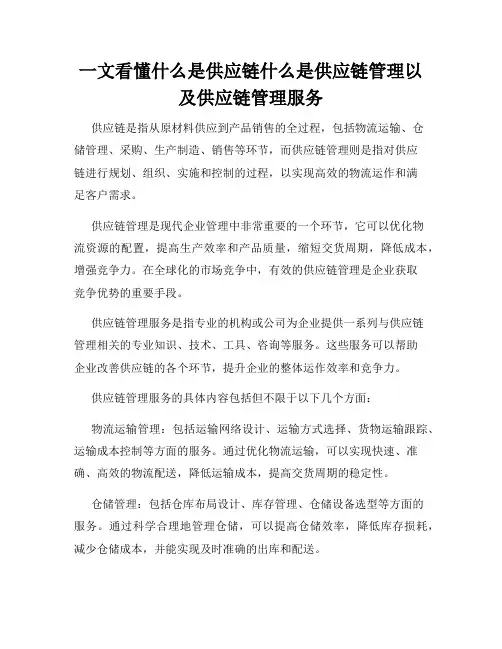
一文看懂什么是供应链什么是供应链管理以及供应链管理服务供应链是指从原材料供应到产品销售的全过程,包括物流运输、仓储管理、采购、生产制造、销售等环节,而供应链管理则是指对供应链进行规划、组织、实施和控制的过程,以实现高效的物流运作和满足客户需求。
供应链管理是现代企业管理中非常重要的一个环节,它可以优化物流资源的配置,提高生产效率和产品质量,缩短交货周期,降低成本,增强竞争力。
在全球化的市场竞争中,有效的供应链管理是企业获取竞争优势的重要手段。
供应链管理服务是指专业的机构或公司为企业提供一系列与供应链管理相关的专业知识、技术、工具、咨询等服务。
这些服务可以帮助企业改善供应链的各个环节,提升企业的整体运作效率和竞争力。
供应链管理服务的具体内容包括但不限于以下几个方面:物流运输管理:包括运输网络设计、运输方式选择、货物运输跟踪、运输成本控制等方面的服务。
通过优化物流运输,可以实现快速、准确、高效的物流配送,降低运输成本,提高交货周期的稳定性。
仓储管理:包括仓库布局设计、库存管理、仓储设备选型等方面的服务。
通过科学合理地管理仓储,可以提高仓储效率,降低库存损耗,减少仓储成本,并能实现及时准确的出库和配送。
采购管理:包括供应商评估、供应商关系管理、采购流程优化等方面的服务。
通过建立良好的供应商关系,可以确保原材料和零部件的质量和供应稳定性,降低采购成本,提高采购响应速度。
生产制造管理:包括生产计划编制、生产过程控制、质量管理等方面的服务。
通过优化生产制造过程,可以提高生产效率,降低生产成本,提高产品质量,并能实现生产计划的准时交付。
销售管理:包括销售预测、渠道管理、客户关系管理等方面的服务。
通过合理预测销售需求,优化销售渠道,建立良好的客户关系,可以提高销售额,降低库存风险,增强市场竞争力。
除了以上几个方面的服务外,供应链管理服务还可以根据企业的实际需求提供定制化的服务,帮助企业解决一些特殊的供应链管理问题,并提供专业的培训和咨询支持,提高企业的供应链管理水平。
供应链管理1. 概述供应链管理是指对管理产品的物流和供应链过程进行规划、协调和控制的活动。
它涵盖了从原材料获取到最终产品交付的整个过程,并且还包括了与供应商和客户之间的沟通和协作。
供应链管理的目标是实现高效、可持续和成本效益的供应链,以满足市场需求并提高企业竞争力。
2. 供应链管理的重要性供应链管理在现代企业中是非常重要的,这是因为它可以帮助企业实现以下几个方面的优势:2.1 成本控制通过有效地管理供应链,企业可以降低原材料采购成本、生产成本和物流成本。
通过优化供应链中的流程和减少资源浪费,企业可以更好地控制成本,并提高利润率。
2.2 资源优化供应链管理可以帮助企业优化物流和生产过程,使资源得到更有效的利用。
通过合理分配资源,避免资源浪费,企业可以提高生产效率,降低生产成本。
2.3 交付准时供应链管理可以确保产品能够按时交付给客户。
通过优化生产和物流过程,并与供应商和客户建立良好的合作关系,企业可以更好地满足客户需求,提高客户满意度。
2.4 资源整合供应链管理可以帮助企业整合供应商和客户资源,在整个供应链中形成紧密的合作关系。
通过与供应商共享信息和资源,企业可以更好地应对市场需求变化,提高供应链的灵活性和响应能力。
3. 供应链管理的关键要素供应链管理包括以下几个关键要素:3.1 供应商管理供应商管理是指与供应商建立合作关系,并通过合理的合同和协议来管理供应商的活动。
这包括选择合适的供应商、协商供应商的价格和付款条件、监督供应商的绩效等。
3.2 物流管理物流管理是指管理产品的物流和分发过程。
包括货物的运输、仓储和库存管理等。
通过优化物流过程,企业可以降低物流成本,提高货物的流通速度,减少库存占用。
3.3 库存管理库存管理是指对企业库存的计划、控制和优化。
通过合理规划和管理库存,企业可以避免废弃品和过剩库存,减少库存成本,提高资金利用效率。
3.4 订单管理订单管理是指管理客户订单的过程。
包括订单的接收、处理和交付等。
供应链管理供应链管理:概述、挑战与优化策略一、引言随着全球化进程的加快和市场竞争的加剧,供应链管理在企业管理中的地位日益突出。
供应链管理是指对企业内外部的物流、信息流、资金流进行全面整合和优化,以提高企业核心竞争力,实现供应链各环节的协同效应。
本文将从供应链管理的概述、挑战与优化策略三个方面进行探讨。
二、供应链管理概述1.供应链管理的定义供应链管理是一种集成的管理思想和方法,通过对供应链各个环节的紧密协作,实现从原材料采购、生产制造、产品分销到最终用户的全过程高效运作,提高企业的市场竞争力。
2.供应链管理的关键要素供应链管理的关键要素包括:物流管理、信息流管理、资金流管理、合作关系管理、风险管理等。
这些要素相互关联,共同构成供应链管理的整体框架。
3.供应链管理的目标供应链管理的目标是在满足客户需求的前提下,实现供应链整体成本的最小化和运作效率的最大化,从而提高企业的核心竞争力。
三、供应链管理面临的挑战1.市场需求波动市场需求的不确定性是供应链管理面临的首要挑战。
企业需要准确预测市场需求,调整生产计划和库存策略,以应对市场变化。
2.供应链协同困难供应链各环节之间的信息传递和资源共享存在障碍,导致供应链协同困难。
企业需要建立有效的协同机制,提高供应链整体运作效率。
3.供应商管理供应商的稳定性、质量、成本等方面对供应链管理具有重要影响。
企业需要加强对供应商的管理,确保供应链的稳定性和产品质量。
4.物流成本物流成本在供应链管理中占有较大比重。
企业需要优化物流运作,降低物流成本,提高供应链整体竞争力。
5.风险管理供应链管理过程中,企业需要应对各种风险,如自然灾害、政治风险、市场风险等。
有效的风险管理机制对保障供应链稳定运作至关重要。
四、供应链管理优化策略1.建立供应链战略合作伙伴关系企业应与供应商、分销商等建立长期稳定的合作关系,实现资源共享、风险共担,提高供应链整体竞争力。
2.优化供应链结构企业应根据市场需求和自身优势,调整供应链结构,简化供应链环节,降低运作成本。
供应链如何做好管理(三篇)供应链如何做好管理 1(1)以顾客为中心,以市场需求的拉动为原动力(2)强调企业应专注于核心业务,建立核心竞争力,在供应链上明确定位,将非核心业务外包(3)各企业紧密合作,共担风险,共享利益(4)对工作流程、实物流程、信息流程和资金流程进行设计、执行、修正和不断改进(5)利用信息系统优化供应链的运作(6)缩短产品完成时间,使生产尽量贴近实时需求(7)减少采购、库存、运输等环节的成本。
供应链如何做好管理 2一、供应链管理把所有节点企业看作是一个整体,实现全过程的战略管理。
传统的管理模式往往以企业的职能部门为基础,但由于各企业之间以及企业内部职能部门之间的性质、目标不同,造成相互的矛盾和利益冲突,各企业之间以及企业内部职能部门之间无法完全发挥其职能效率。
因而很难实现整体目标化。
二、供应链管理是一种集成化的管理模式。
供应链管理的关键是采用集成的思想和方法。
它是一种从供应商开始,经由制造商、分销商、零售商、直到最终客户的全要素、全过程的集成化管理模式,是一种新的管理策略,它把不同的企业集成起来以增加整个供应链的效率,注重的是企业之间的合作,以达到全局最优。
三、供应链管理提出了全新的库存观念。
传统的库存思想认为:库存是维系生产与销售的必要措施,是一种必要的成本。
因此,供应链管理使企业与其上下游企业之间在不同的市场环境下实现了库存的转移,降低了企业的库存成本。
这也要求供应链上的各个企业成员建立战略合作关系,通过快速反应降低库存总成本。
四、供应链管理以最终客户为中心,这也是供应链管理的经营导向。
无论构成供应链的节点的企业数量的多少,也无论供应链节点企业的类型、参次有多少,供应链的形成都是以客户和最终消费者的需求为导向的。
正是由于有了客户和最终消费者的需求,才有了供应链的存在。
而且,也只有让客户和最终消费者的需求得到满足,才能有供应链的更大发展。
供应链如何做好管理 31、加快人才队伍的建设,提高__的学习能力对于企业管理者而言,人才是成功实施供应链管理的关键因素。
什么是供应链管理。
随着全球经济的发展和市场的竞争日趋激烈,企业管理中心转向了供应链管理。
那么,什么是供应链管理?简单来说,供应链管理就是在整个生产和销售过程中,从原材料采购到产品交付,通过优化供应链中的每个流程,以最低的成本和最大的效益来实现企业目标的管理方式。
它可以帮助企业降低库存成本、缩短生产周期、提高产品质量、降低生产成本和提高运营效率。
接下来,我们将从几个方面深入探讨供应链管理。
一、供应链中的环节供应链管理围绕着供应链中的环节展开,包括了从原材料采购、生产制造、运输配送、库存管理、客户服务等方面。
在供应链管理中,每一个环节都会影响到整个供应链的效率和最终业绩。
总的来说,供应链中的各个环节可以分为三个方面:上游供应商、内部流程和下游客户。
1. 上游供应商:供应链中的上游环节是指企业与供应商之间的合作关系。
供应商提供原材料、半成品或零部件,是整个供应链的起点,而供应商的质量、供货周期、配送方式等方面都会影响企业后续的生产和销售。
因此,在供应链管理中,企业需要通过与供应商的合作来建立一个稳定和良好的供应环境。
同时,在选择供应商时,需要综合考虑价格、质量、服务、可靠性等多个方面,以实现最大化利益。
2. 内部流程:企业内部的流程包括了生产制造、物流配送、库存管理等方面。
在供应链管理中,企业需要对生产流程进行优化,缩短生产周期,降低生产成本;同时在物流配送方面,优化物流路线和安排最优配送方式,以减少物流成本。
同时,在库存管理方面,企业需要通过合理的库存规划、清晰的物料分类和便于跟踪管理的系统,降低库存成本。
3. 下游客户:客户是企业经营的最终目的和利润的来源。
因此,在供应链管理中,企业需要考虑客户需求和客户服务。
为客户提供及时、准确的信息和服务,提高客户满意度和忠诚度。
同时,通过不断提高客户服务水平,企业可以建立更稳定的客户关系,增加客户的下单频率和订单量。
二、供应链管理的实现方式在新的市场环境下,供应链管理模式得到了不断的完善和优化。
1.Economies of scale refer to the expansion of production capacity under a certain level of science and technology. The trend that the long-term average cost decline. Which is the downward trend is the long term cost of a curve.2.FMS(flexible manufacturing systems). The flexible manufacturing system is composed of a unified information control system a material transportation system and a set of digital control processing equipment.A automatic machine manufacturing system capable of adapting processing object transformation.3.MRP(materials requirements planning) is defined according to the number of dependent relationship and product mix of goods at all levels to plan for each article is subject to completion of the reference period is the time inverted plan, issued by each item in the length difference is within an industrial manufacturing materials planing management.4.JIT (just in time)The basic principle of JIT logistics is to ensure that all elements of the chain are synchronized and that there must be early identification of shipping and replenishment requirements and, most importantly of all, there must be the highest level of planning discipline.5.SKU (Stock keeping unit) SKUs may be a universal number such as a UPC code or supplier part number or may be a unique identifier used by a specific a store or online retailer.6effective & efficienteffectiveHaving an intended or expected effect.efficientActing or producing effectively with a minimum of waste,expense,or unnecessary effort.7.capability(能力) & competency(实力)8.productivity advantage & value advantageLogistics management can provide a multitude of ways to increase efficiency and productivity and hence contribute significantly to reduced unit costs.Essentially the development of a strategy based upon add values will normally require a more segmented approach to the market. When a company scrutinizes markets closely it frequently finds that there are distinct ‘value segments’. In other words different importance to different benefits. The importance of such benefit segmentation lies in the fact that often there are substantial opportunities for creating differentiated appeals for specific segments.Put very simply, successful companies either have a productivity advantage or they have a ‘value’ advantage or a combination of the two. The productivity advantage gives a lower cost profile and the valueadvantage gives the product or offering a differential ‘plus’over competitive offerings.9.Value chain activities can be categorized into two types-primary activities (inbound logistics, operation, outbound logistics, marketing and sales, and service) and support activities (infrastructure, human resource management, technology development and procurement).These support activities within the firm. Competitive advantage is derived from the way in which firms organize and perform these discrete activities within the value chain. To gain competitive advantage over its rivals, a firm must deliver value to its customers through performing these activities in more efficiently than its competitors or by performing the activities in a unique way that creates greater differentiation.10.TQM(total quality management)Consists of organization-wide efforts to install and make permanent a climate in which an organization continuously improves its ability to deliver high-quality products and services to customers.11.Supply chain against supply chainIt must be recognized that the concept of supply chain management, is in fact no more than an extension of the logic of logistics.The management of upstream and downstream relationship with supplies and customers to deliver superior customer value at less cost to the supply chain as a whole.12.Integrated supply chainStage 1 position of complete function independence where each business function such as production or purchasing does their own thing in complete isolation from the other business functions.Stage 2 companies have recognized the need for at least a limited degree of integration between adjacent function,e.g.distribution and inventory management or purchasing and materials control.Stage 3 requires the establishment and implementation of an “end-to-end “planning frameworkStage 4 represents true supply chain integration in that the concept of linkage and co-ordination that is achieved in stage 3 is now extended upstream to suppliers and downstream to customers.A supply chain could be defined as:The management of upstream and downstream relationship with supplies and customers to deliver superior customer value at less cost to the supply chain as a whole.13.Supply chain is a networkWhilst the phrase ‘supply chain management’is now widely used,it could be argued that it should really be termed ‘demand chain management’ to reflect the fact that the chain should be driven by the market, not by suppliers.equally the word ’chain’ should be replaced by ‘network’since there will normally be multiple customers and customers’ customers to be included in the total system.Extending this idea it has been suggested that a supply chain could more accurately be defined as:A network of connected and interdependent organizations mutually and cooperatively working together to control, manage and improve the flow of materials and information from suppliers to end user.14.The changing logistics environment(1)the customer service explosionThe customer in today’s marketplace is more demanding not just of product quality, but also of service.(2)Time compression(3)Globalization of industry(4)Organizational integration15.The components of customer service(1)Pre-transaction elements (交易前的要素)①Written customer service policy(Is it communicated internally and externally, is it understood, is it specific and quantified where possible?)②Accessibility(Are we easy to contact/do business with? Is there a single point of contact?)③Organization structure(Is there a customer service management structure in place? What levelof control do they have over their service process?)④System flexibility(Can we adapt our service delivery systems to meet particular customer needs?)(2)Transaction elements (交易中的要素)①Order cycle time(What is the elapsed time from order to delivery? What is the reliability/variation?)②Inventory availability(What percentage of demand for each item can be met from stock?) Order fill rate(What proportion of orders are completely filled witnin the stated lead time?)③Order status information(How long does it take us to respond to a query with the required information ?)(3)Post-transaction elements①Availability of spares(What are the in-stock levels of service parts?)②Call-out time(How long does it take for the engineer to arrive and what is the ‘first call fix rate’?)③Product tracing/warranty(Can we identify the location of individual products once purchased? Can we maintain/extend the warranty to customers’ expected levels)④Customer complaints,claims ect.(How promptly do we deal with complaints and returns? Do we measure customer satisfaction with our response?)16.The “Pareto” or 80/20 ruleThe ‘Pareto’ or 80/20 rule’ shows how a typical company might find its profits varying by customer and by product.The curve is traditionally divided into three categories: the top 20 percent of products and customers by profitability are the ‘A’ category; the next 50 percent or so are labeled‘B’and the final 30 percent are category ‘C’. The precise split between the categories is arbitrary as the shape of the distribution will vary from business to business and from market to market.17.ABCLooking first at differences in product profitability, it can be used as the basis for classic inventory control whereby the highest level of service (as represented by safety stock) is provided for the ‘A’products, a slightly lower level for the ‘B’ products and lower still for the ‘C’s’. Alternatively, and probably to be preferred, we might differentiate the stock holding by holding the ‘A’items as close as possible to thecustomer and ‘B’and ‘C’items further back up the supply chain. The savings in stock-holding costs achieved by consolidating the ‘B’ and ‘C’items as a result of holding them at fewer locations would normally cover the additional cost of des patching them to the customer by a faster means of transportation.18.DDPIn essence it is somewhat analogous to customer profitability analysis that it attempts to identify all the costs that attach to a product or an order as it moves through the distribution channel.The idea behind DDP is that in many transactions the customer will incur costs other than the immediate purchase price of the product. often this is termed the total cost of ownership. Sometimes these costs will be hidden and often they can be substantial-certainly big enough to reduce or even eliminate profit on a product item.For the supplier it is important to understand DDP in such as his ability to be a low cost supplier is clearly influenced by the cots that are that product moves through his logistics system.19.BenchmarkingCompetitive benchmarking might simply be defined as the continuous measurement of the company’s products ,services, processes and practices against the standards of best competitors and other companies who are recognized as leaders.20.SCOR model(P107图4.2)SCOR (supply chain operations reference), is built around four major processes: plan----source----make----deliver, and covers the key supply chain activities from identifying customer demand through to delivering the product and collecting the cash. The aim of SCOR is to provide a standard way to measure supply chain performance and to use commom metrics to benchmark against other organizations.21.Supply chain mapping -an example(P114)22.The trend towards globalization in the supply chain23.Lead time24.VMI。